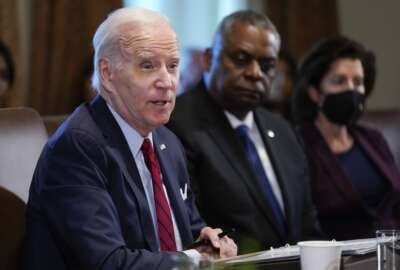GSA plans $70M effort to consolidate agency office space nationwide
The General Services Administration is spending nearly $70 million on a major effort to consolidate federal-agency office space nationwide, the agency announced...
The General Services Administration is spending nearly $70 million on a major effort to consolidate federal-agency office space nationwide, the agency announced Monday.
GSA has plans to continue or start renovations on 19 federally owned buildings across the country, including the headquarters of the Department of Health and Human Services and the Mary E. Switzer Federal Building, both in Southwest Washington, D.C.
The next step after the renovations is consolidating agency office space into the revamped buildings.
Many agencies have real-estate footprints spread across a variety of properties — often in privately leased space. GSA’s project aims to consolidate agency space in a single federally owned building where possible.
Other buildings set for renovation and that will later serve as hubs in regional agency consolidations are the Jacob K. Javits Federal Building in New York City, the Austin Federal Courthouse in Austin, Texas, and the Norfolk Federal Building in Norfolk, Va.
GSA said the initiative will save agencies a total of $17 million in annual rent payments, reduce total leasing costs by more than $38 million and shrink the federal government’s total real-estate footprint by 507,000 rentable square feet. The projects will also reduce energy and water consumption.
“As public servants, we have a responsibility to serve the American people as effectively and efficiently as possible,” GSA Administrator Dan Tangherlini said in a statement. “By consolidating these locations, we are not just eliminating redundant rents and space, but also encouraging collaboration among government workers by creating open workspace.”
Bending the cost curve on leasing
The fiscal 2014 spending bill approved by Congress at the beginning of the year provided the nearly $70 million required for the consolidation projects. For fiscal 2015, GSA is seeking $100 million for similar efforts.
Before GSA turned its focus to streamlining agencies’ real-estate footprints, agency leasing had been on a broad upswing, Tangherlini recently testified before Congress.
“Because of the difficulty of getting all of the resources together at the time that you want to buy or build it, it’s become easier and easier, frankly, for agencies to get into operating leases to meet whatever space need they have,” he told the House Appropriations Subcommittee on Financial Services and General Government during an April 8 hearing.
But GSA’s recent efforts have begun to make a difference. Overall, agencies’ total leased space has been reduced by about 5 million square feet from a high of about 200 million total square feet of leased space in 2011, Tangherlini said.
“We’ve begun to bend the cost curve, if you will, of leasing,” he said.
The slate of planned renovations will adhere to GSA’s Total Workplace program, which eschews the traditional cube-farm layout of older federal offices in favor of a more open, collaborative and efficient design.
GSA itself recently redesigned much of its national headquarters office on F Street in Washington using open-design concepts. Earlier this month, the agency announced it was seeking developers to help continue the renovations, which had stalled recently, and to consolidate about 1,500 additional staff members from regional GSA buildings.
RELATED STORIES:
GSA to swap Fed Triangle properties for developers’ services
GSA declares end to cube farms, unveils new approach to office space
Copyright © 2024 Federal News Network. All rights reserved. This website is not intended for users located within the European Economic Area.





